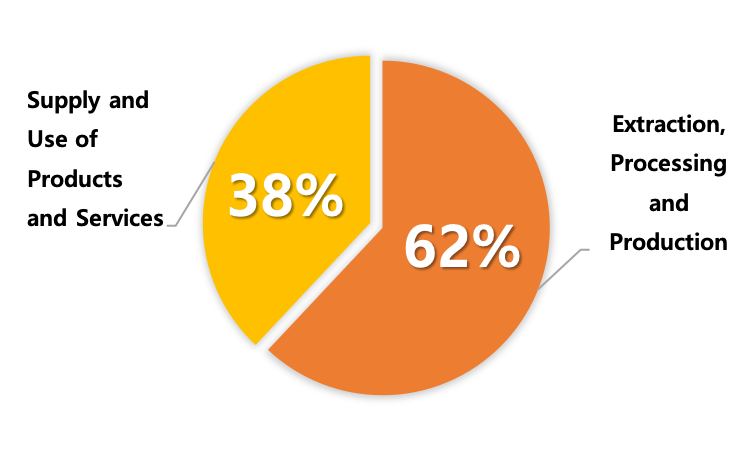The brief calls for moving away from linear economies, which result in natural resource over-exploitation, unsustainable mass production and environmental degradation, toward circular economies, characterized by systems that employ recycling, reuse, remanufacturing and refurbishment to create a closed system.
Read the brief in full below or download the PDF.
Traditional industrial manufacturing approaches have led to unsustainable levels of both production and consumption. This system – marked by a high rate of natural resource extraction, processing, distribution, use and disposal – is commonly called a linear economy. Linear economies result in natural resource over-exploitation, unsustainable mass production and environmental degradation. These outcomes, particularly environmental damages, indicate that the linear economy is obsolete and no longer a feasible path for businesses or consumers. This business-as-usual approach will stall production processes and lead to continued resource depletion, polluting the soil, air, and oceans and, in turn, destroying essential ecosystem functions.

Figure 1: Current Linear Economy
To address this, we must transform all elements of the current linear take>make>waste system into a system where waste is reused as raw materials and completes the resource circle. A circular economy, using a circularity approach, is an economic system aimed at drastically reducing waste through the continual repurposing of resources for sustainability. Circular systems employ recycling, reuse, remanufacturing and refurbishment to create a closed system, minimizing the use of virgin materials and the creation of waste along the producer-to-consumer continuum. A circular economy works best when based on the following principles:
Moving a system towards circularity requires a collective effort from all sectors and stakeholders: businesses, governments and the general public, within a wide range of fields such as industry, agriculture and energy production. Policy stakeholders at different levels have introduced circular economies with varying degrees of success.

Figure 2: Circular Economy

Figure 3: Global greenhouse gases emissions
The following are examples of companies using circularity in their systems.
SEI organizes a round table every year to engage stakeholders involved in or influencing private businesses. The aim is to exchange ideas, insights, tools, and experiences and to encourage collaboration towards innovative solutions that address environmental sustainability, while integrating social inclusion and rights-based approaches. The gathering focuses on circularity and sustainability efforts by businesses, government, researchers and civil society organizations.
The Smart Circular Procurement (CircPro) project promotes the transition to a more circular economy by increasing the implementation of circular procurements in Europe.
This project aims to link the informal and formal sectors to strengthen capacity for improving plastic waste management. It has released a policy guidance tool on the circular economy for the Asia-Pacific region.
The ESSENCE project aims to address the challenge of scaling-up circular economy business models by exploring novel business methods and economic policies. It capitalizes on circular-economy opportunities using a three-pronged approach: theoretical modelling, case study analysis and a collaborative participatory process.
The Initiative on Producer to Consumer Sustainability (P2CS) is an SEI-wide research programme that connects the sustainable production and sustainable consumption agendas. P2CS explores the links and interactions within production-to-consumption systems that include global flows of commodities and the impacts, dependencies and wider dynamics associated with production and consumption, in order to find new opportunities to enhance their sustainability.

Figure 4: SEI as a bridge between sectors
SEI Asia Intern Minjun Sung is a contributing author of this brief
Acciona. What is circular economy?. Retrieved from https://www.activesustainability.com/sustainable-development/what-is-circular-economy/
Asia-Europe Foundation. About. Retrieved from https://www.asef.org/about
BSR. Circular Economy. Retrieved from https://www.bsr.org/en/topics/all-channels/Circular-Economy
Calleja, D. (2019). Why the “New Plastics Economy” must be a circular economy. Reinventing Plastics (19) pp.22-27. Retrieved from https://journals.openedition.org/factsreports/5123
CircPro. Smart Circular Procurement. Retrieved from https://www.interregeurope.eu/circpro/
Circular Economy European Summit. Retrieved from http://www.circulareconomysummit.com/en/home
Circular Economy Club. Retrieved from https://www.circulareconomyclub.com/events/
Ellen MacArthur Foundation. Concept: What is a circular economy? A framework for an economy that is restorative and regenerative by design. Retrieved from https://www.ellenmacarthurfoundation.org/circular-economy/concept
European Union Commission: European Circular Economy Stakeholder Platform Site (Events). Retrieved from https://circulareconomy.europa.eu/platform/en/news-and-events/upcoming-events
Het Groene Brein. What are the environmental benefits of the circular economy? Retrieved from https://kenniskaarten.hetgroenebrein.nl/en/knowledge-map-circular-economy/ce-environmental-benefits/
Het Groene Brein. What are the environmental benefits of circular economy? Retrieved from https://kenniskaarten.hetgroenebrein.nl/en/knowledge-map-circular-economy/ce-environmental-benefits/
IISD. World Circular Economy Forum 2019. Retrieved from https://sdg.iisd.org/events/world-circular-economy-forum-2019-wcef2019/
Ruiz-Real, José Luis, et al. Worldwide research on circular economy and environment: A bibliometric analysis. International journal of environmental research and public health 15.12 (2018): 2699
SCG Circular Way. SD Symposium 10 Years, Circular Economy: Collaboration for Action. Retrieved from https://www.scg.com/sustainability/circular-economy/news_events/news_events_detail/10
Stockholm Environment Institute. About. Retrieved from https://www.sei.org/about-sei
TetraPak, Low-Carbon Circular Economy. Retrieved from https://tpcom-prod.azurewebsites.net/sustainability/circular-economy
The Guardian. Circular Economy: What are the hot topics? Retrieved from https://www.theguardian.com/sustainable-business/circular-economy-hot-topics-talk-point
World Economic Forum. (2014). Towards the circular economy: Accelerating the scale-up across global supply chains. Retrieved from http://www3.weforum.org/docs/WEF_ENV_TowardsCircularEconomy_Report_2014.pdf
Design and development by Soapbox.